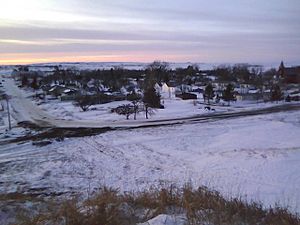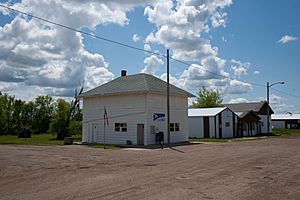Selfridge, North Dakota facts for kids
Quick facts for kids
Selfridge, North Dakota
|
|
|---|---|
 |
|

Location of Selfridge, North Dakota
|
|
| Country | United States |
| State | North Dakota |
| County | Sioux |
| Founded | 1911 |
| Government | |
| • Type | Incorporated City |
| Area | |
| • Total | 0.29 sq mi (0.76 km2) |
| • Land | 0.29 sq mi (0.76 km2) |
| • Water | 0.00 sq mi (0.00 km2) |
| Elevation | 2,192 ft (668 m) |
| Population
(2020)
|
|
| • Total | 127 |
| • Estimate
(2022)
|
121 |
| • Density | 430.51/sq mi (166.42/km2) |
| • Demonym | Selfridgite |
| Time zone | UTC-6 (Central (CST)) |
| • Summer (DST) | UTC-5 (CDT) |
| Zip Code |
58568
|
| Area code(s) | 701 |
| FIPS code | 38-71660 |
| GNIS feature ID | 1036257 |
| Highways | ND 6, ND 31 |
Selfridge is a small city located in Sioux County, North Dakota. It's also part of the Standing Rock Indian Reservation. The city was started in 1911. In 2020, about 127 people lived there. Other towns nearby include Fort Yates and Porcupine. Some older settlements like Maple Leaf and Chadwick used to be close by but no longer exist.
Contents
Selfridge Geography
Selfridge covers a total area of about 0.27 square miles (0.70 square kilometers). All of this area is land, with no water.
Selfridge School System
The Selfridge Public School District has two main buildings for its students. Selfridge Elementary teaches students from kindergarten through 6th grade. The high school is for grades 7 through 12. Around 100 students attend schools in the district.
These school buildings were constructed in the 1950s. They replaced an older school building. The elementary school used to be a private school connected to the St. Philomena Catholic Church.
Community Organizations
Today, several organizations help the town of Selfridge. These include the USDA (United States Department of Agriculture) and the Cedar Soil Conservation District. There is also a senior center, a United States Post Office, and many churches.
History of Selfridge
Selfridge began in 1911. It was built along a Milwaukee Road train line. This line branched off from a larger transcontinental route. The first train station was a boxcar moved to Selfridge in 1917. Trains were very important for the town in its early days. People used them for long-distance travel until the late 1940s.
Selfridge depended on the railroad for almost everything. Groceries, lumber, and mail all arrived by train. The city also shipped out its products, like livestock and grain, using the trains. The railroad was a vital part of Selfridge's growth.
Early Businesses and Homes
The first business in Selfridge was a general store, opened in 1911. Soon after, the Sioux Lumber Company started. This made it easier to get building supplies for new businesses and homes. Some of the first homes were simple shelters. Later, people built more permanent houses, like the J.K. Wead and B.L. Smestad homes, which are still used today.
Farmers came to the Selfridge area hoping to grow flax. The land was open range, meaning cattle roamed freely and had to be herded. The area had good land for farming and excellent hills for ranching. Horses were used for pulling wagons and for farm work. Most of the prairie was plowed using walking plows.
Travel was slow and hard because of rough prairie trails and few roads. Good roads were not built until the 1930s. This happened when the W.P.A. program began. Roads were built using horses and simple machines.
Town Growth and Challenges
For the first eight years, Selfridge was an unorganized community. It didn't have local laws or supervision. Residents tried to make Selfridge the county seat before Sioux County became separate from Morton County, but they didn't succeed. Later, in the 1950s, they tried again to move the county seat from Fort Yates to Selfridge, but this also failed.
By 1925, Selfridge had 51 homes and 63 businesses. It had churches, schools, banks, stores, and even a newspaper. By 1930, the city's population had more than doubled.
During the Great Depression in the 1930s, many local men worked for the W.P.A. to support their families. They earned between $25 and $42 a month. The city park was started, and the City Auditorium was built. Sidewalks were also installed. The National Youth Association (NYA) gave jobs to many young people, who earned $6.00 a month.
Selfridge has always had a volunteer fire department. However, it wasn't formally organized until 1973. Fundraisers were often held to buy equipment. Many businesses and homes in Selfridge have been lost to major fires over the years.
Farming Changes and Population Shifts
Farming in the Selfridge area has changed a lot in the last 100 years. Farmers now use modern methods, including chemicals for weed and insect control. The Cedar Soil Conservation Office helped farmers with planning and building dams. Modern farming has reduced the need for farm workers. However, it has increased the need for farmers to manage their finances and production carefully.
Selfridge reached its highest population in the late 1950s and early 1960s. A lot of building was happening then. By the 1970s, the population started to decrease, like in many small towns. People could buy things cheaper elsewhere.
Young people also began leaving the community. In the late 1970s, some worried that the school might have to close. This trend of people moving from rural areas to cities was happening across the country.
On September 16, 2024, the post office in Selfridge caught fire. The building, which had been a bank and then a grocery store before becoming the post office, was completely destroyed.
Transportation in Selfridge
The main way to get to Selfridge is by using North Dakota Highway 6. The Milwaukee Road train line that went through the town was closed in 1983. This left Selfridge without train access.
Selfridge Population Data
| Historical population | |||
|---|---|---|---|
| Census | Pop. | %± | |
| 1910 | 25 | — | |
| 1920 | 153 | 512.0% | |
| 1930 | 351 | 129.4% | |
| 1940 | 329 | −6.3% | |
| 1950 | 343 | 4.3% | |
| 1960 | 371 | 8.2% | |
| 1970 | 346 | −6.7% | |
| 1980 | 273 | −21.1% | |
| 1990 | 242 | −11.4% | |
| 2000 | 223 | −7.9% | |
| 2010 | 160 | −28.3% | |
| 2020 | 127 | −20.6% | |
| 2022 (est.) | 121 | −24.4% | |
| U.S. Decennial Census 2020 Census |
|||
In 2010, there were 160 people living in Selfridge. These people lived in 59 households, with 36 of them being families. The population density was about 592.6 people per square mile.
About 33.1% of the people were White, and 58.1% were Native American. About 6.9% were from two or more races.
In 2010, 32.2% of households had children under 18 living with them. The average household had 2.71 people, and the average family had 3.28 people. The average age in Selfridge was 34.5 years old.
Selfridge Climate
Selfridge has a climate with big changes in temperature throughout the year. Summers are warm to hot and often humid. Winters are cold, sometimes very cold. This type of weather is known as a humid continental climate.
See also
 In Spanish: Selfridge (Dakota del Norte) para niños
In Spanish: Selfridge (Dakota del Norte) para niños


